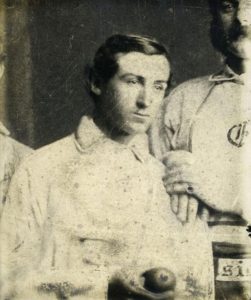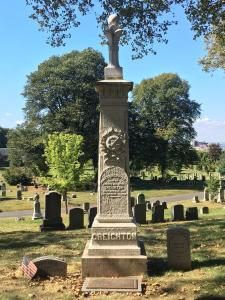by John Semlak | Oct 18, 2018 | Green-Wood Cemetery, New York City HIstory, On this day

Morse in 1840
On October 18th, 1842, Samuel Morse had a telegraph cable laid from the Battery in Lower Manhattan to Governor’s Island. From a booth at Castle Garden (today’s Castle Clinton) he successfully transmitted messages. It is believed to be the first successful submarine telegraph cable. Unfortunately, the next day the cable was inadvertently hauled up by the crew of a merchant ship and Morse’s experiment abruptly ended. However, the next year Morse would receive funding from Congress to build a telegraphic cable from Baltimore to Washington.
by John Semlak | Oct 12, 2018 | Abolitionists, Civil War, New York City HIstory, New York City Newspapers, On this day, Sports History, Woodlawn Cemetery

William Cauldwell 1824-1907
On this day on October 12th 1824, William Cauldwell was born. He would be the manage the New York Sunday-Mercury newspaper from 1850-1894. At at time when most newspapers didn’t publish on Sunday, he established the Mercury as one of the city’s most influential newspapers. The Mercury was the first newspaper to cover baseball regularly, starting with a match reported in 1853. The paper invented the phrase “national pastime.” Cauldwell hired journalist Henry Chadwick, the most famous promoter of baseball of the 19th Century, to cover the sport. During the Civil War, he found a cheap way to get extensive coverage from the front by inviting soldiers to send pieces and have them published, which was a regular feature. Under Cauldwell the newspaper published published writings of Mark Twain as early as 1864, as well as poems by Walt Whitman (and gave his Leaves of Grass a positive review), and actress Adah Menkin. The Mercury also published many writings of humorist Robert H. Newell, a favorite of Abraham Lincoln.
Cauldwell would eventually embark on a disastrous attempt to make the Mercury a daily paper and leave the paper. He had a career in politics as well in New York and Westchester County. He’s buried at Woodlawn Cemetery.
by John Semlak | Sep 24, 2018 | #NYCHistory, Baseball History, New York City HIstory, NYC Sports, On this day, Sports History

John Cox Stevens
On this day on September 24th, 1785, John Cox Stevens was born at the Stevens family estate in Hoboken NJ at Castle Point, the site of today’s Stevens Institute of Technology. Stevens was a livelong sportsman. He was a founding member of the New York Yacht Club and later nicknamed “the Commodore”. He led the ‘America’ syndicate which built the yacht that won the first ever America’s Cup for the NYYC in 1851. He also served as president of the Jockey Club and was responsible for the Great North-South Match of 1823, won by the Long Island-born thoroughbred American Eclipse.
Stevens also played an important role in the growth of early baseball. In the 1840s, a number of New York City’s early baseball clubs began to search outside of Manhattan for places suitable to practice. The city was increasingly difficult for playing baseball. So, several clubs including the pioneering New York Knickerbockers began to regularly cross the Hudson River by ferry to Hoboken to play at the Elysian Fields. Stevens ran the ferries and profited immensely. The Stevens family also owned the Elysian Fields and profited from the teams playing there.
by John Semlak | Oct 18, 2017 | Baseball History, Cricket, Green-Wood Cemetery, NYC Sports, On this day, Sports History

Jim Creighton of the Brooklyn Excelsiors
On October 18th 1862 in a rowhouse on 307 Henry Street in today’s Brooklyn Heights neighborhood, a 21-year-old baseball and cricket phenom named Jim Creighton died from injuries sustained while playing in a baseball match. He was the sport’s first on-field fatality and widely considered to be baseball’s first superstar. He was the most feared pitcher of his day.
James ‘Jim’ Creighton was born in Manhattan in 1841 and moved to Brooklyn with his father. At age 17 he started playing for the Brooklyn Niagaras. While pitching against the Brooklyn Stars in 1859, he was noticed for his ‘low, swift delivery’ as a pitcher. Pitchers were required to throw underhand in that era. Though Creighton’s pitches were considered within the rules, they were perhaps aided by some hidden, but illegal, wrist movement. Creighton’s opponents were impressed, and soon he was playing for the Stars, A year later he was playing for the Brooklyn Excelsiors, probably the second strongest team in Brooklyn, and America, behind the mighty Brooklyn Atlantics.

The entrance Creighton’s house at 307 Henry, now an apartment building called the ‘Creighton’.
The Excelsiors were desperate to surpass their crosstown rivals, so much so that in all likelihood the paid Creighton ’emoluments’ under the table, making him what some historians call baseball’s first professional. Organized baseball was still officially amateur. The Excelsiors nevertheless became a profitable attraction for the league. Anchored by their star, they went on a barnstorming tour in 1860 to Albany, Buffalo, Canada, Baltimore, and other stops.
Creighton was not a one-sport man. Like many baseball players of his time he also played professional cricket simultaneously and starred for the American Cricket Club and the fabled St. George Cricket Club.
The exact cause of Creighton’s death is the subject of debate to this day. Legend has it he ruptured his abdomen while hitting a home run against the Unions of Morrisania. The truth is probably a little less dramatic. Accounts vary but it appears he ruptured his abdomen playing cricket and then aggravated it while pitching against Morrisania. In any case he died four days after the baseball match at his home. His Excelsior teammates mourned at their clubhouse at 133 Clinton St a few blocks away.
The mystery surrounding the cause of Creighton’s death is in part because of the rivalry at the time of cricket and baseball as America’s most popular sport. Baseball was on the rise at the time but it was still far from certain whether cricket or baseball would rule as A

Creighton’s grave
merican’s most popular team sport. Many baseball officials feared that if the injury were blamed on baseball, the sport’s popularity would suffer. These fears turned out to be unfounded; in fact, baseball used Creighton’s death as as a means to create a sense of history and nostalgia. Creighton was immediacy held as the game’s first superstar. His grave at Green-Wood Cemetery became an attraction, decorated with a baseball carved onto the headstone.
In later years, Creighton’s grave would become a model for plaques used at the Baseball Hall of Fame and at Monument Park in Yankee Stadium. Creighton’s house on Henry Street still stands and is now called “The Creighton.” The Excelsior clubhouse at 133 Clinton also in Brooklyn Heights still stands and now has a plaque honoring the team and Creighton (Though several details on the plaque are wrong; Creighton is inaccurately credited with inventing the curveball.). The death of James Creighton marked the beginning of baseball celebrating its past, something which the sport loves to do.





